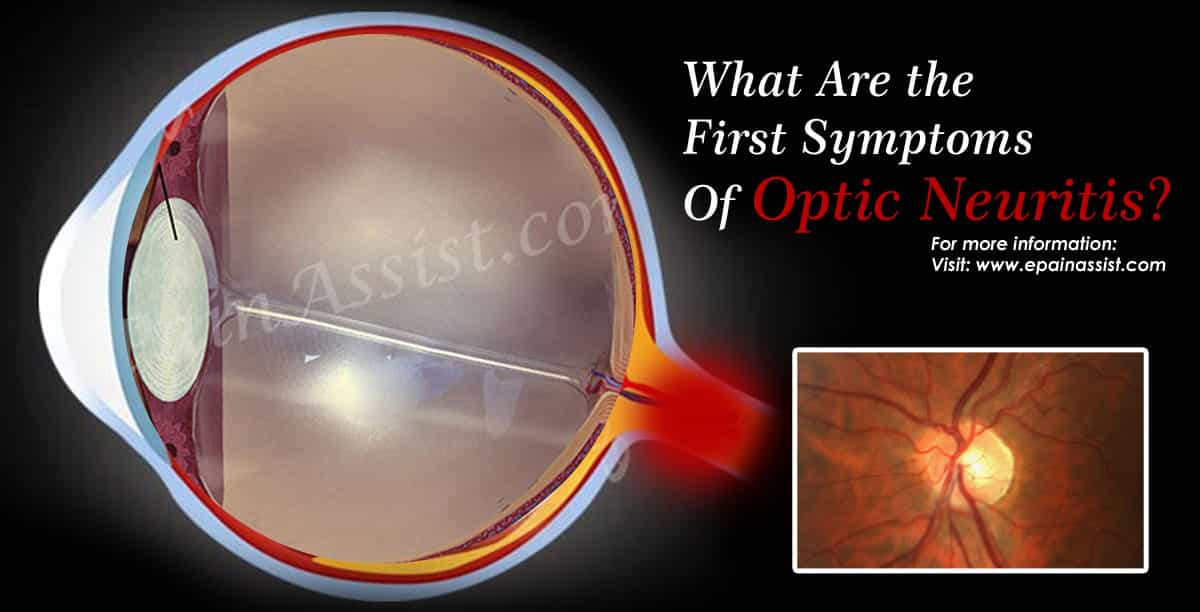Optic neuritis is a disorder of the eye in which the nerve of the eye becomes inflamed or infected. There is no specific reason that causes this condition. Optic neuritis is closely related to multiple sclerosis (a potentially disabling disease of the brain and spinal cord). When the inflammation gets worsened, it reduces the ability of healing and prevents the attack of viruses.
This disease can occur to anyone at any age, but several instances arise in females who are between the ages of 25 to 40. Optic neuritis can also arise with other diseases or immune conditions, such as lupus.
What Are the First Symptoms Of Optic Neuritis?

Most individuals who have a single episode of optic neuritis sooner or later recover their vision without treatment or medications. There are a few unique symptoms of optic neuritis:
Pain: Most people who develop optic neuritis have eye soreness that is aggravated by eye movement. Sometimes the pain feels like a dull ache behind the eye. You might have pain, particularly when you move your eyes. In some instances, the pain resolves on its own.
Vision Loss In One Eye: Adults usually get optic neuritis in only one eye, but children may have it in both (about one in 10 times). The optic nerve is responsible for sending messages from your eyes to your brain so that you can interpret visual images. Therefore, when the nerve fiber gets infected or inflamed, it results in the loss of vision.
Periocular Pain: Optic neuritis typically presents with subacute visual loss and periocular pain that often resolve spontaneously. More than eighty percent of patients with optic neuritis have periocular pain 1,2
Dyschromatpsia: Also referred to as color vision impairment is a typical symptom of optic neuritis. Among patients with selective color defects, the defect was likely to change over time. Hence, in assessing color deficiencies related to optic neuritis, the level of the central visual function must be measured.
Photopsia– Several conditions affecting the eyes can cause photopsia to occur and optic neuritis is one such condition. This is a rare symptom however photopsia (the presence of perceived flashes of light in the field of vision) was noticed in 30% of instances.
Uhthoff’s Phenomenon– When the condition starts worsening with an increase in temperature, Uhthoff’s sign is noticed. It can result in fatigue, balance issues, and reduced cognitive and sensory functions.3
How Do You Test For Optic Neuritis?
Optic neuritis is often diagnosed through a physical exam based on the symptoms and past medical history of the patients suspected of this condition. The ophthalmologist will advise undergoing the following eye tests:
Routine Eye Exam: An eye doctor can diagnose optic neuritis by examining the vision color, how eyes respond to light, and how well the eye can identify the letters in the vision chart.
Ophthalmoscopy: The optic nerve will be envisioned by a slit lamp with a high positive lens or by using direct ophthalmoscopy to examine the back of the eye, particularly the optic disc. This test is often recommended for patients with recurrent optic neuritis.
Pupillary Light Reaction Test: If an optic nerve laceration is present the affected pupil will not constrain to light when light is flashed in the pupil during the swaying light reaction test.
Other tests may include
- MRI scan for identifying the retrobulbar intra-orbital segment of the optic nerve and it may reveal focal edema of the optic nerve
- Blood tests to check the antibodies that can cause severe optic neuritis.
- Optical coherence tomography to measure the thickness of the optic fiber layer which is thinner than the optic neuritis.4,5
- Optic neuritis – Symptoms and causes – Mayo Clinic https://www.mayoclinic.org/diseases-conditions/optic-neuritis/symptoms-causes/syc-20354953
- Optic Neuritis: Risk Factors, Causes, and Symptoms – Healthline https://www.healthline.com/health/optic-neuritis
- Optic Neuritis Causes, Treatment, Diagnosis & Symptoms https://www.medicinenet.com/optic_neuritis/article.htm
- Optic neuritis – Diagnosis and treatment – Mayo Clinic https://www.mayoclinic.org/diseases-conditions/optic-neuritis/diagnosis-treatment/drc-20354958
- The Diagnosis and Treatment of Optic Neuritis – NCBI https://www.ncbi.nlm.nih.gov/pmc/articles/PMC4581115/
Also Read:
- Optic Neuritis or Retrobulbar Neuritis: Epidemiology, Causes, Signs, Treatment, Tests
- Does Optic Neuritis Show Up On MRI & Can Eye Test Detect It?
- Can Stress Cause Optic Neuritis & Does It Cause Headaches?
- What Is The Difference Between Optic Neuritis & Optic Neuropathy?
- Can You Have Optic Neuritis In Both Eyes & Does It Always Lead To MS?
